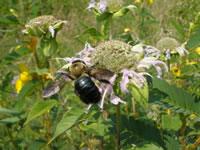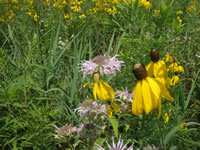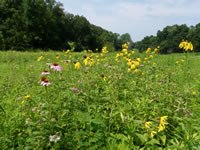Eastern Region Viewing Area
LOCATION and PHOTOS
 Bumble bee on wild bergamot (Monarda fistulosa). Photo by Kirk W. Larson, Hoosier National Forest.
Bumble bee on wild bergamot (Monarda fistulosa). Photo by Kirk W. Larson, Hoosier National Forest.
 Wild bergamot (Monarda fistulosa) and gray-headed coneflower (Ratibida pinnata). Photo by Kirk W. Larson, Hoosier National Forest.
Wild bergamot (Monarda fistulosa) and gray-headed coneflower (Ratibida pinnata). Photo by Kirk W. Larson, Hoosier National Forest.
 Summer (July) landscape of the Mifflin Restoration. Photo by Steve C. Harriss, Hoosier National Forest.
Summer (July) landscape of the Mifflin Restoration. Photo by Steve C. Harriss, Hoosier National Forest.
Mifflin Restoration
Forest: Hoosier National Forest
District: Tell City Ranger District
Description: The Mifflin Restoration Wildflower Viewing Area is an opening of about 10 acres, and is part of a larger complex of forest and wildlife openings consisting of over 186 acres that the Hoosier National Forest maintains as an Early Successional Habitat and Native Pollinator Resource Area. In 2009, the Forest seeded the prior 10-acre pasture with a native seed mixture of 17 different wildflowers. The site contains four newly created vernal pools that hold water seasonally. The Forest planted an additional 20 species adjacent to the vernal pools and other selected areas. Seeding of wildflowers, including 11 native grasses, occurred in the nearby fields. The area now provides an abundant variety of wildflowers that serve as an important source for pollinators such as native bees, moths, butterflies, and other insects. Visitors often observe wildlife such as turkeys, deer, bats, and many songbirds.
Wildflower Viewing Information: July is the peak month for observing most of the plants at the site, but because of the diverse habitat and abundance of species, visitors can view differing displays of colorful wildflowers throughout the entire summer. The most abundant plants include wild bergamot (Monarda fistulosa), partridge pea (Chamaecrista fasciculata), purple coneflower (Echinacea purpurea), gray-headed coneflower (Ratibida pinnata), and lesser amounts of rattlesnake master (Eryngium yuccifolium), blackeyed Susan (Rudbeckia hirta), and butterfly milkweed (Aslepias tuberosa). Late summer plants often seen are showy tickseed (Bidens aristosa) and ironweed (Vernonia altissima), with scattered clumps of various species of goldenrod (Solidago spp.) and asters (Symphyotrichum spp.).
Safety First: Always carry a snack, insect repellant, water and a light raincoat, and wear (comfortable) hiking boots when hiking. If proceeding off the roadside, please use caution for unseen holes or dips in the terrain underneath the dense vegetation. Anticipate biting ticks and chiggers during June, July, and August. The county gravel road leading to the Mifflin Restoration Wildflower Viewing Area is suitable for passenger cars, but to go beyond the site to other nearby areas the road is often rutted and has loose gravel, so a high clearance vehicle is the best choice.
Directions: From Interstate Highway I-64, go north on Indiana State Highway 237 and turn west on the Otter Creek Road near the community of Grantsburg. Continue west about 2.5 miles to the Old Felker Road and turn left heading west crossing Otter Creek. Continue about 0.4 miles passing a corner residence to a small pull-off on the left (south), where an interpretive sign indicates the viewing area.
Ownership and Management: U.S. Forest Service, Hoosier National Forest, Tell City Ranger District.
For more information, contact the Tell City Ranger District at (812) 547-7051 or the Forest Headquarters Office at (812) 275-5987.
Closest Towns: English, Saint Croix, Sulphur, Indiana

